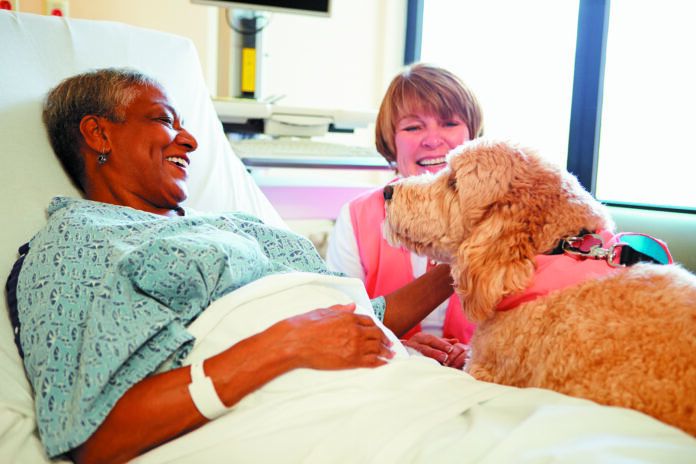Pain is the reason for 80 percent of all visits to hospital emergency rooms, yet conditions in emergency room departments can actually contribute to pain intensity. Bright lighting, persistent noise, extended wait times, lack of distractions…all of these emergency room factors can increase actual pain as well as the perception of pain. But research conducted at the emergency department of Canada’s Royal University Hospital in Saskatchewan suggests that a visit by a therapy dog can reduce not only feelings of pain but also anxiety and depression and, at the same time, enhance a sense of wellbeing.
Researchers at the University of Saskatchewan made the finding when they compared about 100 emergency room patients visited by a therapy dog with another 100 or so who did not interact with a dog during their visit. All of the patients were either waiting to be seen by a doctor, had already begun treatment, or had been admitted to the hospital but were still waiting for a bed.
The upshot: Those patients who spent just a short while with a therapy dog and the dog’s handler reported experiencing reductions in pain, anxiety, and depression and improvements in their sense of wellbeing compared to those patients who had not interacted with a dog.
These results are not the first indication that therapy dogs can do people good in hospital emergency rooms. A study at an Indiana hospital indicated that emergency room patients who interacted with a therapy dog experienced less anxiety than similar patients who were not visited by a dog. Additionally, fewer of those patients who met with a dog needed pain medication. Another study that took place in Canada showed that therapy dogs ratcheted down emergency room patients’ levels of distress and proved a welcome distraction from the discomfort they were experiencing.
Gotta like dogs
In the current study as well as others, patients were able to choose whether they would be eligible for receiving a visit from a therapy dog. People who were afraid of dogs or did not like them were excluded from the research. It’s an important point. A therapy dog is not going to be able to help someone who, for whatever reason, is not comfortable in a dog’s company.
But for people like Your Dog readers who feel good about canine companionship, some attention from a therapy dog in a hospital emergency room might be just the thing. We tend to think of therapy dogs visiting patients already up in their hospital rooms recovering from an illness or operation, but going by the results of this study and others, they appear to have a place in the area reserved for those just coming into the hospital in the throes of an emergency.
In Canada, at least eight emergency departments at hospitals in provinces across the country — from Alberta and Saskatchewan in the west to Ontario and Prince Edward Island in the east — have welcomed therapy dogs into their midsts. Maybe the trend will start to pick up south of the Canadian border.





